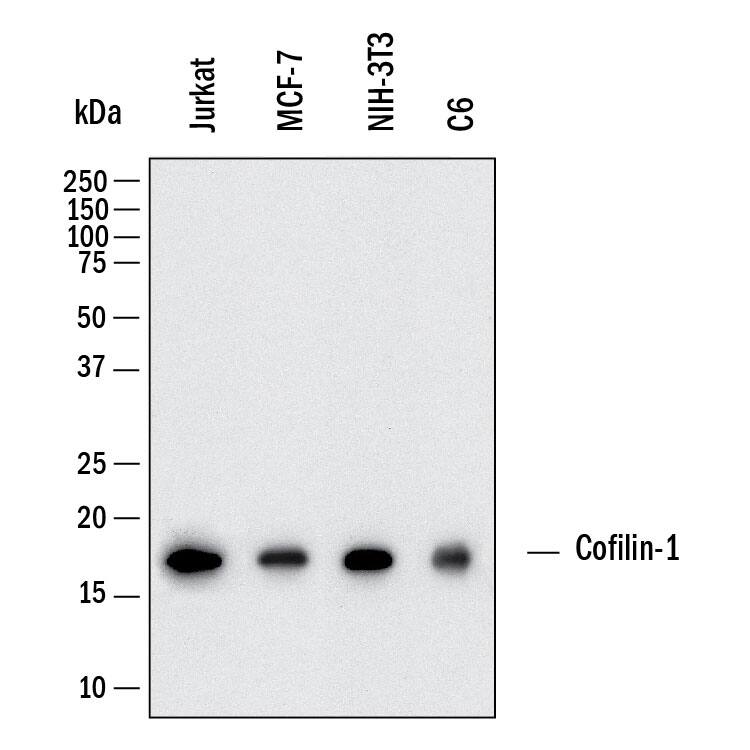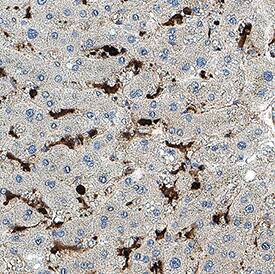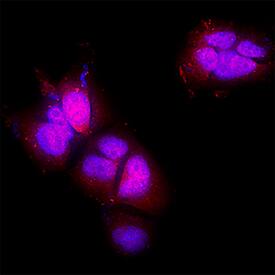Human CFL1 Antibody
R&D Systems, part of Bio-Techne | Catalog # MAB11669


Conjugate
Catalog #
Key Product Details
Species Reactivity
Human
Applications
Immunocytochemistry, Immunohistochemistry, Simple Western, Western Blot
Label
Unconjugated
Antibody Source
Monoclonal Mouse IgG2B Clone # 1093310
Product Specifications
Immunogen
Synthetic Peptide
Accession # P23528
Accession # P23528
Specificity
Detects a synthetic peptide specific for human CFL1 around aa 30 in Direct ELISA.
Clonality
Monoclonal
Host
Mouse
Isotype
IgG2B
Scientific Data Images for Human CFL1 Antibody
Detection of Human, Mouse and Rat CFL1 by Western Blot.
Western Blot shows lysates of Jurkat human acute T cell leukemia cell line, MCF-7 human breast cancer cell line, NIH-3T3 mouse embryonic fibroblast cell line and C6 rat glioma cell line. PVDF membrane was probed with 0.5 µg/ml of Mouse Anti-Human CFL1 Monoclonal Antibody (Catalog # MAB11669) followed by HRP-conjugated Anti-Mouse IgG Secondary Antibody (Catalog # HAF018). A specific band was detected for CFL1 at approximately 17 kDa (as indicated). This experiment was conducted under reducing conditions and using Western Blot Buffer Group 1.Detection of CFL1 in Liver
CFL1 was detected in immersion fixed paraffin-embedded sections of liver using Mouse Anti-Human CFL1 Monoclonal Antibody (Catalog # MAB11669) at 5 µg/ml for 1 hour at room temperature followed by incubation with the Anti-Mouse IgG VisUCyte™ HRP Polymer Antibody (Catalog # VC001) or the HRP-conjugated Anti-Mouse IgG Secondary Antibody (Catalog # HAF007). Before incubation with the primary antibody, tissue was subjected to heat-induced epitope retrieval using VisUCyte Antigen Retrieval Reagent-Basic (Catalog # VCTS021). Tissue was stained using DAB (brown) and counterstained with hematoxylin (blue). Specific staining was localized to the nucleus and cytoplasm. View our protocol for IHC Staining with VisUCyte HRP Polymer Detection Reagents.Detection of CFL1 in MCF-7 Human Cell Line.
CFL1 was detected in immersion fixed MCF-7 human breast cancer cell line using Mouse Anti-Human CFL1 Monoclonal Antibody (Catalog # MAB11669) at 8 µg/ml for 3 hours at room temperature. Cells were stained using the NorthernLights™ 557-conjugated Anti-Mouse IgG Secondary Antibody (red; Catalog # NL007) and counterstained with DAPI (blue). Specific staining was localized to the nucleus and cytoplasm. View our protocol for Fluorescent ICC Staining of Cells on Coverslips.Applications for Human CFL1 Antibody
Application
Recommended Usage
Immunocytochemistry
3-25 µg/mL
Sample: Immersion fixed MCF-7 human breast cancer cell line
Sample: Immersion fixed MCF-7 human breast cancer cell line
Immunohistochemistry
3-25 µg/mL
Sample: Immersion fixed paraffin-embedded sections of liver
Sample: Immersion fixed paraffin-embedded sections of liver
Simple Western
10-100 µg/mL
Sample: Exosome Standards (LNCaP) (Catalog # NBP3-11687), Exosome Standards (PC-3) (Catalog # NBP2-49856) and MCF-7 human breast cancer cell line
Sample: Exosome Standards (LNCaP) (Catalog # NBP3-11687), Exosome Standards (PC-3) (Catalog # NBP2-49856) and MCF-7 human breast cancer cell line
Western Blot
0.5 µg/mL
Sample: Jurkat human acute T cell leukemia cell line, MCF-7 human breast cancer cell line, NIH-3T3 mouse embryonic fibroblast cell line and C6 rat glioma cell line
Sample: Jurkat human acute T cell leukemia cell line, MCF-7 human breast cancer cell line, NIH-3T3 mouse embryonic fibroblast cell line and C6 rat glioma cell line
Formulation, Preparation, and Storage
Purification
Protein A or G purified from hybridoma culture supernatant
Reconstitution
Reconstitute lyophilized material at 0.2 mg/ml in sterile PBS. For liquid material, refer to CoA for concentration.
Formulation
Lyophilized from a 0.2 μm filtered solution in PBS with Trehalose.
Shipping
Lyophilized product is shipped at ambient temperature. Liquid small pack size (-SP) is shipped with polar packs. Upon receipt, store immediately at the temperature recommended below.
Stability & Storage
Use a manual defrost freezer and avoid repeated freeze-thaw cycles.
- 12 months from date of receipt, -20 to -70 °C as supplied.
- 1 month, 2 to 8 °C under sterile conditions after reconstitution.
- 6 months, -20 to -70 °C under sterile conditions after reconstitution.
Background: CFL1
References
- Yin X, Li X, Jiang H, Lin X, Ma Z, Chen X, Teng Q, Zhang J, Jin J. CFL1 is Implicated in Chronic Myeloid Leukemia Response during Imatinib Therapy. J Cancer. 2024 Mar 4;15(8):2424-2430. doi: 10.7150/jca.92202. PMID: 38495482; PMCID: PMC10937266.
- Xing J, Wang Y, Peng A, Li J, Niu X, Zhang K. The role of actin cytoskeleton CFL1 and ADF/cofilin superfamily in inflammatory response. Front Mol Biosci. 2024 Jul 24;11:1408287. doi: 10.3389/fmolb.2024.1408287. PMID: 39114368; PMCID: PMC11303188.
Long Name
cofilin 1
Alternate Names
CFL, cofilin, cofilin-1, HEL-S-15
Gene Symbol
CFL1
UniProt
Additional CFL1 Products
Product Documents for Human CFL1 Antibody
Product Specific Notices for Human CFL1 Antibody
For research use only
